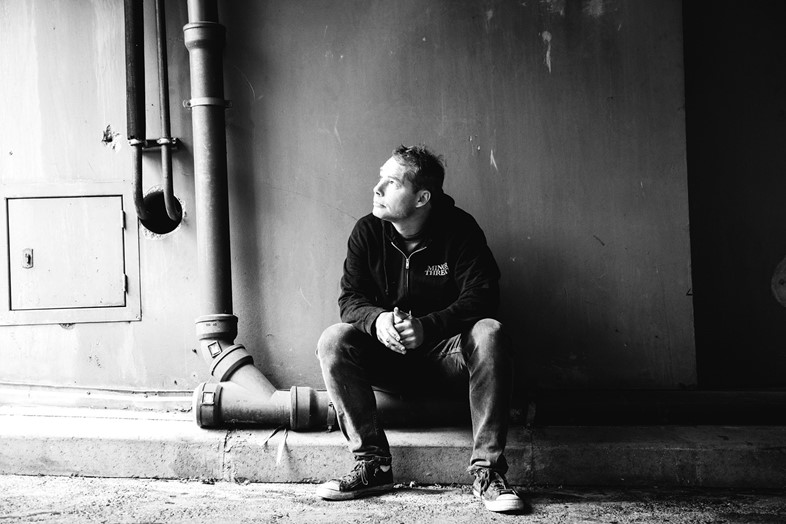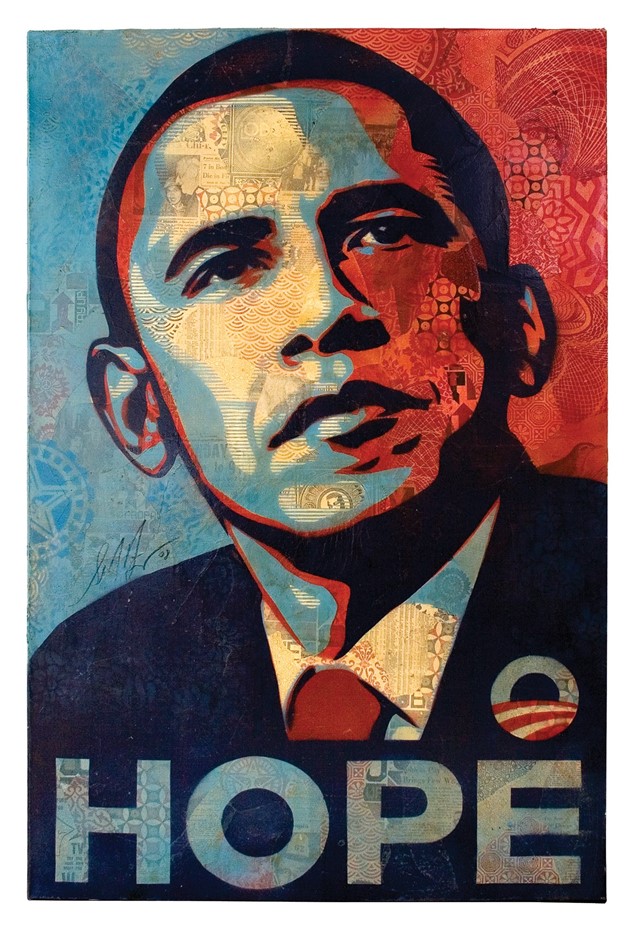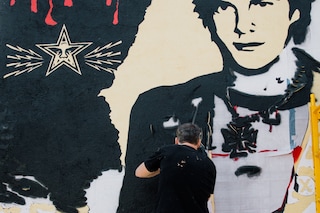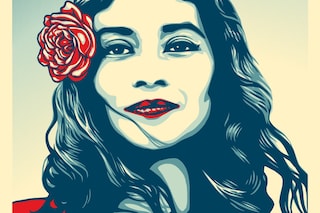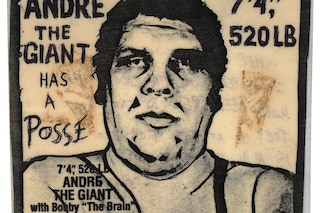The artist and skate punk behind the viral Barack Obama ‘Hope’ poster shares his tips
As the creative force behind the Barack Obama “Hope” poster, Shepard Fairey is, to put it frankly, single-handedly responsible for one of the most iconic political images in modern history. Consisting of a stylised, stencil drawing of the young Democratic nominee staring resolutely into the distance, the poster encompassed the feeling of genuine, progressive optimism that came with the Obama campaign of 2008. It’s an image that came to define not only the Charleston-born artist, but the America of then.
Today, in 2017, Shepard Fairey is a street art institution. Alongside the “Hope” poster, he can call on a 9-foot mural of Nelson Mandela in Johannesberg, a portrait of Ai Weiwei in support of Chinese artists and Obey Clothing’s (the brand he founded in 2001) “Obey Awareness Programme” as proof of his ability to blend art and activism on the most gargantuan of scales. At the time of writing, he’s one of the largest – and most influential – of supporters of the Silverlake Conservatory of Music, a non-profit musical education organisation founded by his friend and Red Hot Chilli Peppers bassist Flea. For someone who Washington Post once referred to as ‘a skate punk – with a secretary’, he’s sitting on an empire
In conjunction with his work with Silverlake – and at a time where America needs activist voices more than ever – and their upcoming benefit on September 9 (RSVP here) we spoke to Fairey about his beginnings and the unique power of creating visuals for public locations; be it as a tool for political change, or just a defiant act of rebellious humour. From the artist who proved that an image can help put someone in the White House, here’s your ‘how to’ guide for all things Shepard Fairey street art.
CHANNEL YOUR DEFIANCE
“I grew up drawing and painting, but my interest in do-it-yourself art really took off when I got into skateboarding and punk rock – both of which encouraged handmade creative things. It wasn't a big leap from there to street art, because I was already making homemade stencils and stickers. I fell in love with New York City's graffiti, and I wanted to do something similar but using graphic art that could be reproduced with stencils, stickers, and posters. I started my first crude sticker campaign in 1989.
Street art, whether political or not, is an act of defiance that requires risk and courage, so I think if you've made it that far in terms of commitment, it's just logical to want to say something as well.”
UTILISE YOUR TOOLS
“Before the Internet, street art had to be viewed first-hand or in subcultural magazines that usually had small circulations and distribution. Still, it was the most democratic art form viewed by people as they lived their daily lives, opposed to going out of their way to go to a gallery or museum. Pre-internet the street artists who became highly regarded had to be accomplished with their style but equally important, if not more so, had to be prolific. The great thing about street art in the Internet era is that people across the globe can see pieces from a city that they may not ever travel to. Because street art is already democratic, I like that the internet democratises it even more.
On the other hand, the internet has made it easy for people who would like to exploit the hip cache of street art to do a few pieces on the street and promote them vigorously online. I'd rather see the artists who are really dedicated to doing powerful work that is free for the public be the ones who benefit from the commercial potential that street art has more recently found. I promote my work through most of the social media platforms with the intent of demonstrating the value of actually doing work on the street and taking risks in both application and content.”
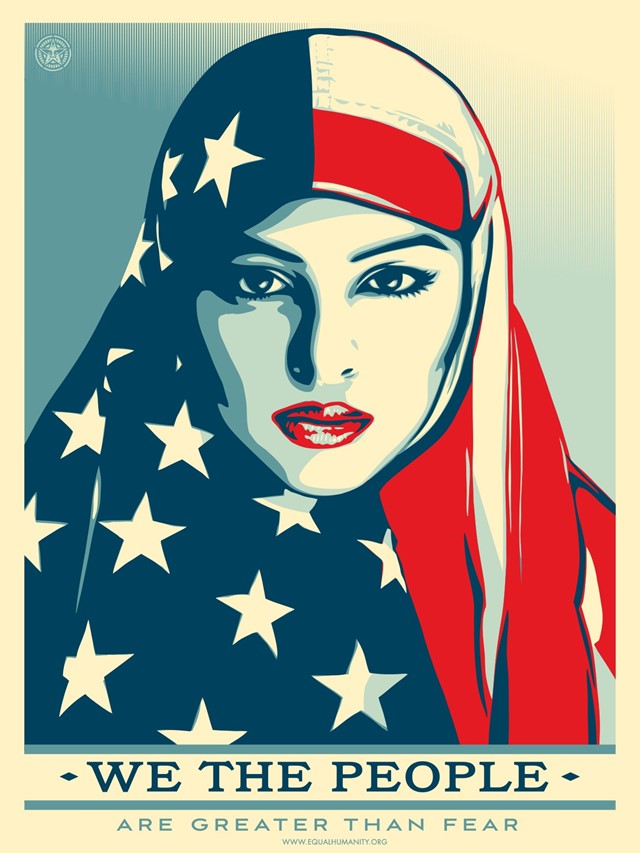
NARRATE YOUR TIME
“(The ‘Hope’ picture engaged with people) because Obama was an incredibly inspiring orator and a symbol of a very different philosophy from the Bush administration. I can give the art itself a small amount of credit in that it did deviate from the very narrow usual parameters of political art by being an illustration and by using slightly different shades of red, white, and blue. (But) I think I was lucky to make an image that could be the symbol for that exciting moment in time.
Does art have to be political? Definitely not. There are plenty of people who have no idea what they're talking about but can make pretty pictures. However, I do wish that those people who do care and do take some time to understand the issues facing our world would have the courage if they make art to deal with those issues in the art they make.”
“Street art, whether political or not, is an act of defiance that requires risk and courage, so I think if you've made it that far in terms of commitment, it's just logical to want to say something as well” – Shepard Fairey
FIND WHAT WORKS
“When looking for a location, I'm striving to balance visibility, potential longevity, and consideration for property. I always want my work to add rather than detract, even though art and vandalism are very subjective.
Street art doesn't have to be approved by a curator. For certain artists, the idea is more important than the art itself, and they may do something that's more conceptual than visually appealing. An example that I like a lot, and I can't remember the artist's name, was a text-driven hijacking of a sign in the median between two lanes which just said: ‘The Median is the Message.’ Sometimes I think a good chuckle is worth just as much as a compelling picture.”
DON’T LOSE YOUR EDGE
“The moment a street artist gets precious, I think their moves aren't as exciting.”
